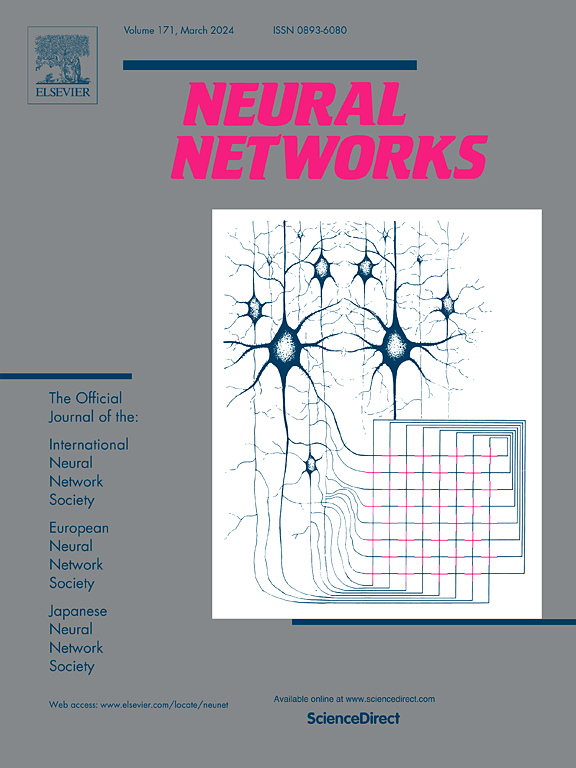利用伪标签增强三维医学图像分割中基础模型的特征识别
IF 6.3
1区 计算机科学
Q1 COMPUTER SCIENCE, ARTIFICIAL INTELLIGENCE
引用次数: 0
摘要
医学图像分割基础模型的开发依赖于大规模样本。然而,对三维医学图像进行注释比对二维自然图像进行注释更耗时,因此很难收集到足够的注释样本。虽然伪标记提供了扩展注释数据集的潜在解决方案,但它可能会引入噪声标签,从而产生系统偏差,特别是影响较小解剖结构的分割性能。为此,我们提出了一个伪标签丰富分割框架(PESF),它集成了置信度过滤和基于微扰的课程学习。首先,我们的伪标记方法应用了一个经过良好预训练的基础模型,为以前未注释的器官类别生成伪标签,有效地扩展了原始数据集中的类别数量。随后,我们开发了一种基于置信度的过滤机制,利用特征提取模块和置信度预测模块相结合,定量评估和过滤掉低质量的伪标签,从而最大限度地减少了噪声伪标签对模型优化的不利影响。此外,提出了一种将课程学习与高斯随机扰动相结合的渐进式采样策略,系统地引入从简单到复杂的训练样本,从而增强了模型在不同形状和大小器官之间的泛化能力。此外,我们的理论分析表明,通过增加嵌入空间中类决策边界之间的角距,合并这些额外的伪标记类可以增强特征识别。实验结果表明,与基线SAM-Med3D (Amos, FLARE22, WORD, BTCV)相比,PESF在总体平均骰子相似系数(DSC)方面提高了6.8%,特别是在具有挑战性的解剖结构(如胰腺和食道)方面。代码可在https://github.com/lonezhizi/PESF上获得。本文章由计算机程序翻译,如有差异,请以英文原文为准。
Enhancing feature discrimination with pseudo-labels for foundation model in segmentation of 3D medical images
Development of medical image segmentation foundation models relies on large-scale samples. However, it is more time-consuming to annotate 3D medical images than 2D natural images, making it challenging to collect sufficient annotated samples. While pseudo-labeling offers a potential solution to expand the annotated dataset, it may introduce noisy labels that can create systematic biases, particularly affecting the segmentation performance of smaller anatomical structures. To this end, we propose a pseudo-label enriched segmentation framework (PESF), which integrates confidence filtering and perturbation-based curriculum learning. To begin with, our pseudo-labeling approach applies a well-pretrained foundation model to generate pseudo-labels for previously unannotated organ categories, effectively expanding the number of classes in the original dataset. Subsequently, we develop a confidence-based filtering mechanism, leveraging a feature extraction module combined with a confidence prediction module to quantitatively assess and filter out low-quality pseudo-labels, thereby minimizing the detrimental effects of noisy pseudo-labels on the model’s optimization. Furthermore, a progressive sampling strategy that integrates curriculum learning with Gaussian random perturbations is proposed, systematically introducing training samples from simpler to more complex cases, thereby enhancing the model’s generalization capability across organs of varying shapes and sizes. Additionally, our theoretical analysis reveals that incorporating these extra pseudo-labeled classes strengthens feature discrimination by increasing the angular margins between class decision boundaries in the embedding space. Experimental results demonstrate that PESF achieves a 6.8% improvement in the overall average Dice Similarity Coefficient (DSC) compared to the baseline SAM-Med3D on (Amos, FLARE22, WORD, BTCV), with particularly gains in challenging anatomical structures such as the pancreas and esophagus. The code is available at https://github.com/lonezhizi/PESF.
求助全文
通过发布文献求助,成功后即可免费获取论文全文。
去求助
来源期刊

Neural Networks
工程技术-计算机:人工智能
CiteScore
13.90
自引率
7.70%
发文量
425
审稿时长
67 days
期刊介绍:
Neural Networks is a platform that aims to foster an international community of scholars and practitioners interested in neural networks, deep learning, and other approaches to artificial intelligence and machine learning. Our journal invites submissions covering various aspects of neural networks research, from computational neuroscience and cognitive modeling to mathematical analyses and engineering applications. By providing a forum for interdisciplinary discussions between biology and technology, we aim to encourage the development of biologically-inspired artificial intelligence.
 求助内容:
求助内容: 应助结果提醒方式:
应助结果提醒方式:


